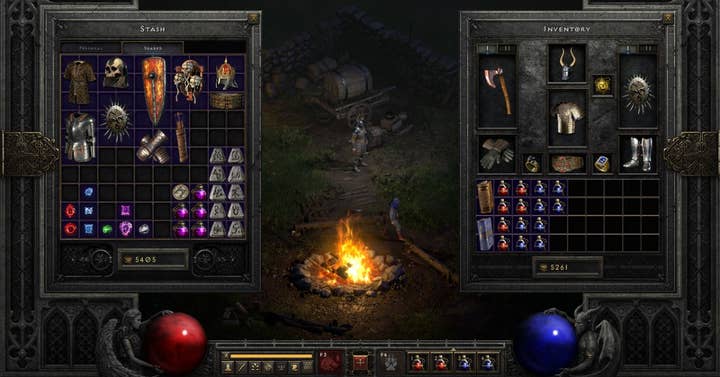Game designers must be included in the conversation around tech ethics | Opinion
Benjamin Goldman reflects on how design decisions made to benefit players can be used to exploit them later on
In 1996, David Brevik -- then a designer at Blizzard North -- had run into a curious problem during the development of Diablo: players were spending more time managing their inventories than battling back the minions of hell.
The core draw of Diablo was that it gave players copious amounts of loot. You start with one sword that does +1 damage, soon you come across a sword that does +5 damage, and within a few minutes a player will have accumulated a pile of breastplates, helmets, and weapons. With limited inventory space, however, players would constantly need to figure out which pieces of loot were worth keeping.
What was once a helpful user interface trick is now a key feature of a multi-billion dollar industry some researchers liken to gambling
Brevik's solution was to use a simple design trick -- he leveraged color to denote value. With this system, players could quickly glance at the color of an item and know which pieces of loot they should keep.
The color-coded loot system Brevik designed proved so efficient that decades later it's become part of the universal language of games. Other fantasy games like World of Warcraft have adopted it, and so too have hit titles like Call of Duty and Fortnite. Virtually the entire constellation of free-to-play mobile games uses a variation of this design technique as a core part of its strategy for staying in business.
But there is a key distinction between the system in Diablo and the new crop of loot-based games and virtual worlds: today's players are charged real-world money for the chance of winning in-game loot. What was once a helpful user interface trick has now transformed into a key feature of a multi-billion dollar industry that some researchers have likened to gambling.
In other words, the design no longer serves the player -- it serves the business.

Who does design serve?
There is nothing inherently wrong about design being used to drive big business. If it weren't for the outsized value of design in the digital age, the design industry wouldn't be where it is today: growing, maturing, and moving closer to the center of every business.

But design is about more than big business, it's about negotiating the most elegant compromise between the needs of the user, technology, and business. Yet in recent years, we've seen the consequences of what happens when good design is repurposed to prioritize the needs of business above all, especially in the world of big tech.
Aza Raskin, a designer who worked at Mozilla, publicly expressed regret for his role in creating the "infinite scroll." Much like how Brevik proposed color-coding as a way to simplify sorting through loot, Raskin first proposed the infinite scroll as a way to reduce the friction of sorting through page after page of Google search results.
"At best, [it's] somewhat annoying," he wrote in 2007. "At worst [it's] aggravating trying to remember which page had the result you are looking for."
Today, games are not the box on the shelf of a store - they're the store itself
Removing the cumbersome pagination and replacing it with a self-populating infinite scroll proved to be a dramatic UX improvement -- enough that years later it became a foundational feature of the ethically dubious attention economy, which describes the category of app or website that competes to capture the most minutes of a user's day.
Today, Raskin likens his design to "behavioral cocaine" and wishes it never existed. Similar public disavowals have been made by the creator of the now-ubiquitous Like button, and by the creator of the retweet feature.
In each of these cases, a simple user experience feature yielded massive business benefits. Over time, however, the business benefits began overriding all other interests -- including the interests of the user. The resulting consequences have rejuvenated the public conversation around design ethics, the responsibility of designers in ensuring their work is not used for ill, and what the design community can do to push back.
With big business comes big responsibility
For a long time, game designers could avoid these thorny questions due to how simple the business model of gaming was. A game was a product sold in the store, just like any book or toy. Once a player owned a game, they didn't have to think about spending more money and because of this, game designers could focus their attention on optimizing the in-game experience for the player.
But today, games are not the box on the shelf of a store -- they're the store itself. They are places where people go to pass time, meet friends, and spend money. There are in-game economies, virtual marketplaces, and unique currencies -- from Fortnite's V-bucks to Roblox's Robux. And the models for monetizing games are as diverse as the games themselves, including subscription services, microtransactions, advertising, downloadable content (DLC), season passes, licensing deals, loot boxes and others.
All of this has helped drive gaming to the explosive era of growth that it now enjoys, and has paved the way for the complex virtual worlds fast approaching on the horizon-what many have taken to calling the "metaverse."
But it has also complicated the work of game designers, who can no longer reliably predict how their designs will be used by business.

This problem is compounded by the fact that there is still much that is unknown about the unique implications of designing for virtual worlds in which there seem to be more ways for people to spend their hard-earned dollars and fewer protections.
In the real world, consumer protections ensure a degree of transparency in the marketplace; property rights are guaranteed by law; and potentially harmful industries like gambling are heavily regulated. In the realm of video games, however, these concepts are at best poorly understood, and at worse dismissed as irrelevant.
But as games continue to evolve from short-lived entertainment products into persistent online services and virtual worlds for millions of people, these questions are taking on new urgency.
If designers want to avoid repeating the same mistakes made in the digital age, the design community must do more to understand the unique implications of designing for these experiences -- and include game designers in the emerging conversation around design ethics.
Benjamin Bertram Goldman is a writer and filmmaker based in Brooklyn, NY where he works as the director of InVision Films, a documentary studio that focuses on the intersection of design, business, and technology. He primarily writes about games and the future of entertainment, and occasionally tweets about it at @benfromTV.
